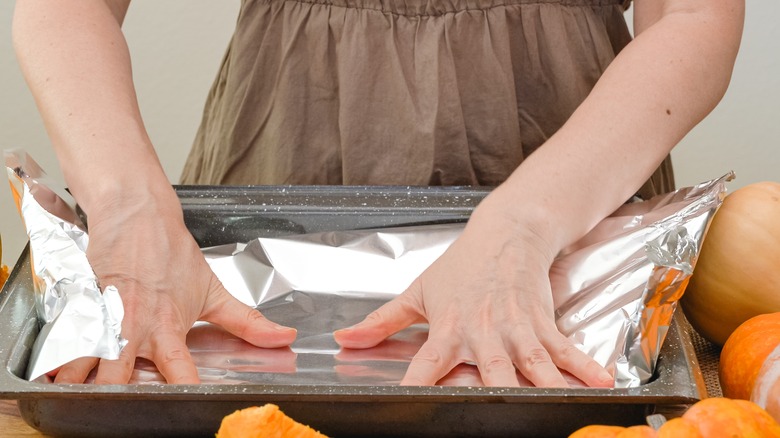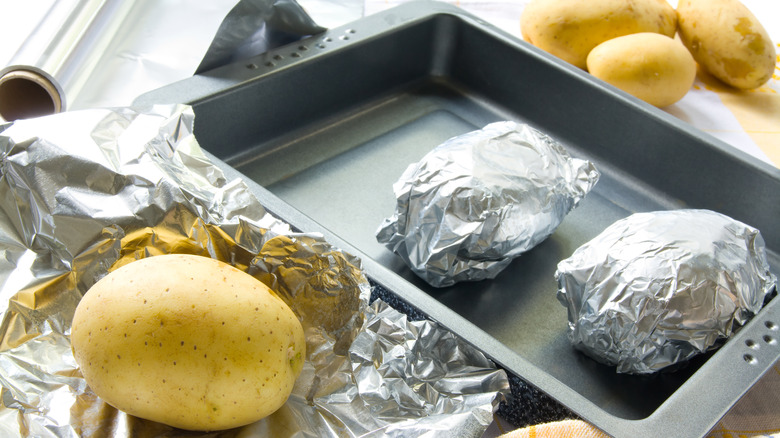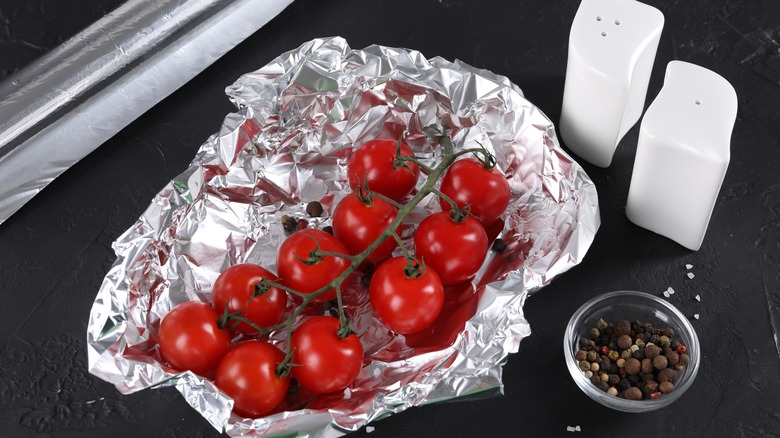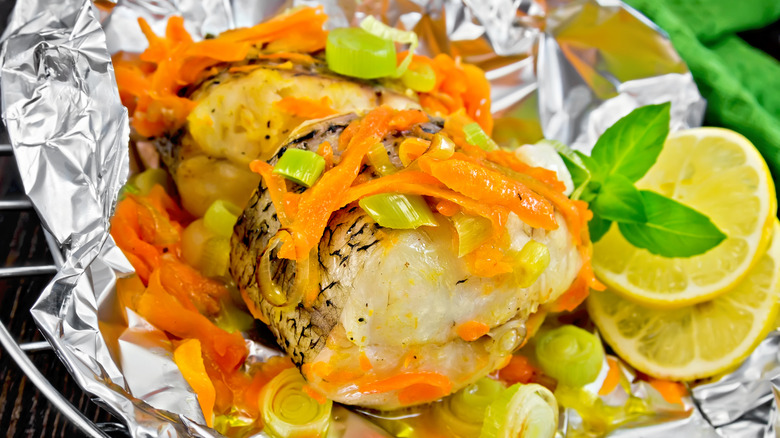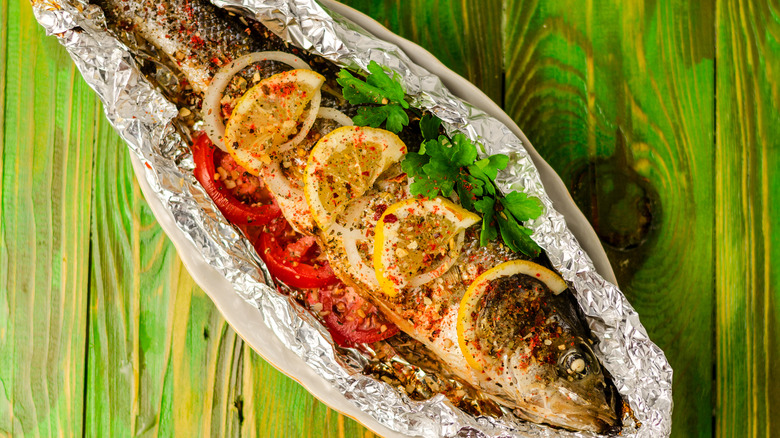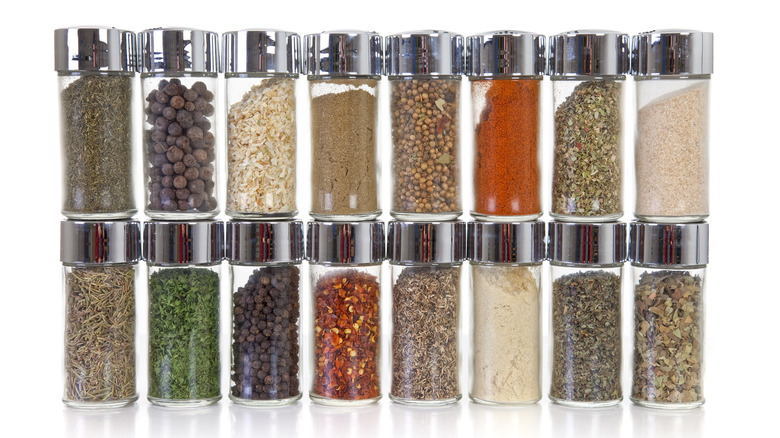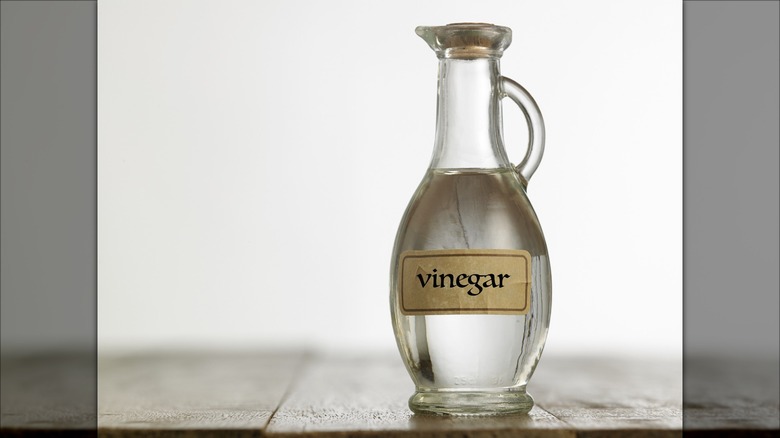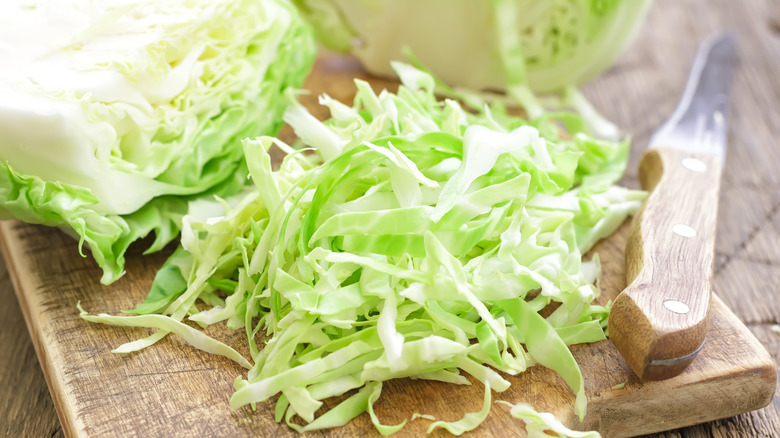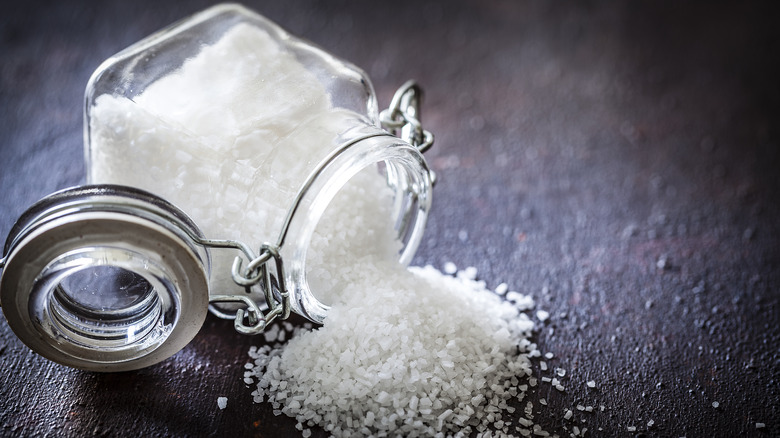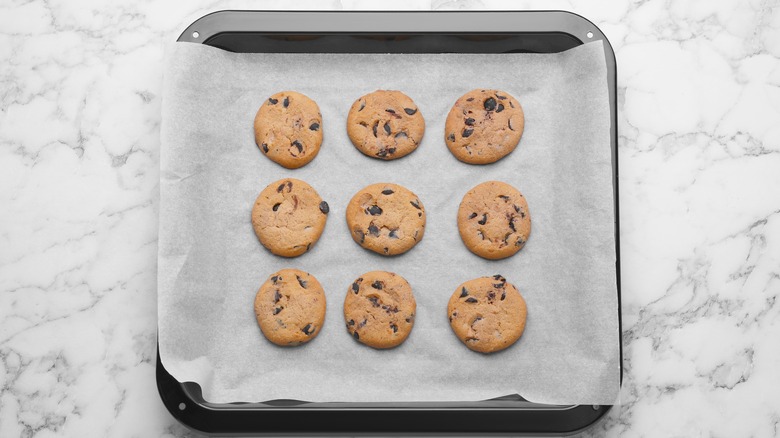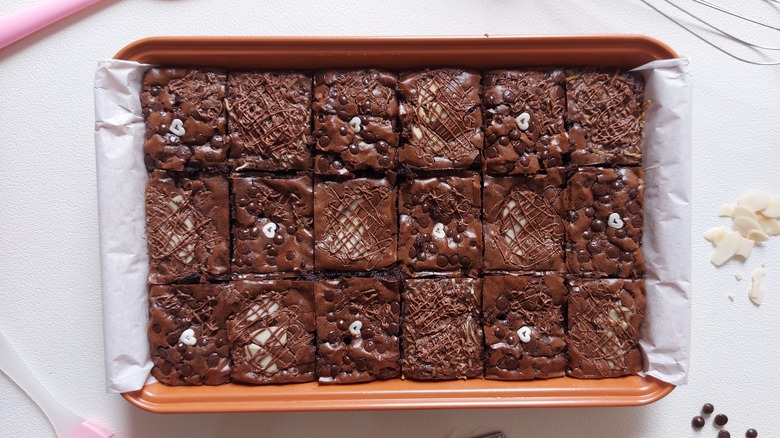10 Foods You Might Want To Avoid Cooking In Aluminum Foil
In the kitchen, the versatile aluminum foil has so many uses. From wrapping leftovers to covering dishes before cooking, this flexible metallic sheet comes in handy. It's used to line cooking surfaces and catch spills in the kitchen to reduce how much you need to clean afterward. Another benefit of aluminum foil is that you can use it over and over again. Don't just discard it after each use; toss it in the dishwasher to maximize its lifespan.
Using aluminum foil to cook certain foods helps them turn out perfectly as it traps moisture and distributes heat for a uniformly cooked yet moist dish. This metal sheet is excellent for different cooking methods and types of equipment, including stovetops, ovens, and microwaves. However, aluminum foil might not be the best choice for all dishes. Sometimes, it may lead to taste, color, and texture changes. If you don't want to make a blunder in the kitchen, keep reading to note foods you want to avoid cooking in aluminum foil.
1. Potatoes
Wrapping potatoes in aluminum foil before baking helps trap heat within. But the problem with cooking potatoes in this metallic sheet is that they contain lots of water, which has nowhere to go. Steam rising during cooking condenses on the inner surface of the metal sheet. This drops back on the potatoes, making them soggy, wet, and undesirable.
Then again, there's a much bigger issue with cooking potatoes in aluminum foil: food safety. The warm, moist condition inside the aluminum foil also lacks Oxygen and is the perfect growing medium for dangerous bacteria like Clostridium botulinum. This microorganism makes harmful toxins that affect the muscles and can ultimately cause death.
If you want to make the best baked potatoes with a crisp exterior while remaining soft and creamy inside, ditch the aluminum foil. Instead, coat them in a bit of oil and place them in the oven directly. Remember not to store potatoes wrapped in aluminum foil so harmful microorganisms don't move in.
2. Tomatoes
If your recipe uses a generous amount of tomatoes, you shouldn't cook it in aluminum foil. You see, tomato juice is slightly acidic, but that's enough to dissolve the metal. This problem doesn't simply end during cooking, as it also happens when you store tomato-rich food in a metal container covered with an aluminum sheet as well. This setup triggers an electrolytic reaction that further eats away at the aluminum foil.
One Quora user shared their experience, saying, "Wrapping a lasagna piece in aluminum foil fro a couple of days in the fridge and you will notice that the acids in the lasagna (tomato sauce as well as the cheese and bechamel or white sauce topping) will eat into the foil and little spots of aluminum will be on your food."
Besides spotting the unsightly aluminum deposits in your food, this process changes the taste. The rich, sweet, tart tomato flavor becomes tainted with a metallic tang. To preserve your food's original flavor, consider using a parchment paper or even a solid oven-safe lid during cooking. Additionally, store foods like lasagna in non-reactive containers like glass and plastic.
3. Tart fruits
Citrus fruits bring a distinct sweet and savory flavor to foods, whether you're using them as dressing or in soups. But you don't want to make the mistake of cooking them in aluminum foil. Acidic fruits like citruses are strong enough to break down the metal. This reaction produces an aluminum salt that gets deposited on the surface of your food. This transforms how the food tastes, tainting it with the strong metallic taste of aluminum.
Aluminum foil isn't the only culprit here, as storing tart fruits in any aluminum utensil may also result in this reaction. A better way to cook and store acidic fruits is to swap the aluminum foil and bowls with ceramic and glass dishes. These materials are inert and won't react with the acids in these foods.
If you still want to cook with aluminum utensils, consider waiting until the food is ready and out of the pan to add lemon juice or other acidic fruits. One Reddit user added, "As a former cook, just some advice (if it hasnt been given already), add lemon juice after they come out of the oven. Acid strength breaks down under hot conditions."
4. Fish
Grilling fish in foil helps keep it intact and spreads the heat evenly to cook it all through. Another plus is that you don't get burned fish bits on the grill that are tough to remove. While these seem like great benefits, they're certainly not worth it if you end up with an awful-tasting dish. As the grill cooks the fish, all the spices and flavors come together, but aluminum from the sheet also seeps in, giving your meal an unpleasant metallic taste.
If you grill on top of lemons or add other ingredients that could react with aluminum, such as salt and heavy spices, expect more metal to leach out of the metal sheet. According to a study published in the Food Chemistry Journal, the longer the fish stays on the grill, the more the aluminum builds up. Additionally, if you're also cooking fish filets with the skin on, you certainly want to avoid wrapping them in aluminum foil. The property of aluminum as a good conductor works against this dish as the heat gets through too fast, cooking the fish without creating the desired crispy exterior.
5. Spicy foods
Using aluminum foil when cooking might not be appropriate, depending on how many spices and the specific ones you use. Certain herbs and seasonings like paprika, chili, and cumin may react with the metal sheet, drawing aluminum into your food. This is particularly important considering how many food recipes depend on these rich spices for flavor.
Heavily spiced foods cooked in aluminum foil may taste odd or slightly metallic. The longer it sits in this metal sheet, the more aluminum it draws into your dish. Sometimes, the reaction doesn't cause a significant change in the flavor. But even when it tastes the same, many consumers still worry about how this metal leaching into food may affect health. Consider using cookware that can handle spices without breaking down, like ceramic, cast iron, and stainless steel. This also helps dispel worries about food safety and makes sure your food flavor doesn't get ruined.
6. Vinegar
Vinegar comes in various types and flavors, but they all contain acetic acid. This kitchen staple brings a tangy punch to elevate food flavor. Although it may be a weak acid, it's got enough strength to dissolve metals like aluminum. Like with other acidic or spicy ingredients, once enough of this metal gets into your food, it completely changes how it tastes.
If you're concerned about the metallic foil changing the flavor of your dishes, you could use an alternative that won't leave deposits on your food, like parchment paper. On Reddit, one user shares that you could try putting "a piece of parchment paper between the foil and the food to protect the acid in the food from reacting with the foil and giving it a metallic flavor."
But you don't always have to cook the meal with the vinegar. Whenever possible, delay adding it till after the meal is cooked. Once you unwrap the food from the foil, transfer it to a container that can handle the acidity like a glass bowl, then drizzle the vinegar on top.
7. Cabbage
Cabbages and aluminum utensils, including foil wraps, don't go together. In fact, cooking cabbages wrapped in this metallic sheet is a sure way to ruin an otherwise great meal. First, the dish may most likely not turn out to be the most appealing to look at. This is because cooking cabbages wrapped in this metal sheet discolors it. But aluminum foil isn't the only culprit; other utensils made from this metal, including pots, pans, and spoons, can ruin this vegetable.
Another issue with cooking cabbage in aluminum foil is that it reacts with the vegetable and changes the taste. Instead of a slightly sweet fresh-tasting vegetable, you're left with a harsh, metallic-tasting, discolored mess. If you don't want to ruin your cabbage dishes, ditch all things aluminum and swap them out for more durable materials like cast iron. This prevents unnecessary alterations in the appearance and taste of your food.
8. Salty foods
Just like acidic foods, salty foods will erode aluminum foil if left on it for too long. You might even see the deep spots on the metal sheet when you take it off. Common culprits are processed foods like bacon, but if you're heavy-handed when adding salt while cooking, it would likely fall under this category. As the salt eats away at the metal, it gets transferred to the food as aluminum salt deposits. And here lies the first problem: this blue liquid salt scattered on the dish's surface doesn't look appealing.
However, the issues with cooking salty foods in aluminum foil don't just stop with appearance, as it extend to taste as well. The blue aluminum salt now covering the food may overpower everything else. It tastes like you're biting into metal, essentially ruining the whole meal. In this case, you're better off using cooking utensils that don't have aluminum for salty foods.
9. Cookies
Aluminum foil makes the messy oven much easier to clean after baking, but doing this can ruin your batch of cookies. Generally, you want the heat to be distributed evenly when baking cookies so that it gets cooked all around with no burned bits. This is where Aluminum foil causes trouble, as it's an excellent conductor of heat and gets hot quickly. This is bad news for the part of the cookie sitting directly on the metal sheet because it'll likely get burned before the rest of it gets cooked.
If you don't use aluminum foil while baking cookies, you're not sentenced to spending several hours cleaning up. To get the litter under control without ruining your treats, consider switching to parchment paper as your oven liner. Since it's not metal, it won't heat one part of the cookies much faster than the rest. Therefore, you end up with an evenly cooked batch without dealing with many dirty utensils.
10. Brownies
While baking brownies in an aluminum foil pan is generally acceptable, you shouldn't cover the pan with this metal sheet, or you'll get a soggy mess. This happens because as the brownies cook, steam rises and needs a place to go. But with the aluminum foil lid on, it's locked in and eventually settles on the inside of the cover. The liquid drops back on the brownies as it condenses, creating a mushy mix.
If you want to make perfect chewy brownies every time, ditch the cover, aluminum or otherwise, as these treats don't typically take long to cook. Just grease your pan to prevent burning and pour in the batter directly. You can also place parchment paper between the barter and the pan. The next step is to put this in an oven at high temperatures of up to 400 degrees F (204.44 degrees C) till it's cooked. You can tell it's ready when the edges pull away from the pan.
